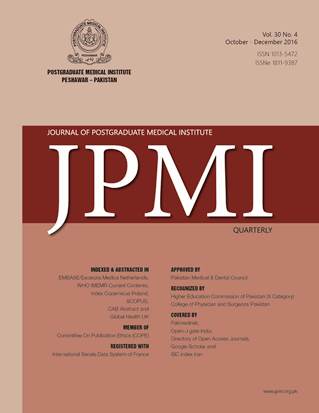OCCUPATIONAL HEARING LOSS: A CROSS-SECTIONAL SURVEY IN A MANUFACTURING INDUSTRY AT BAHAWALPUR
Main Article Content
Abstract
Objective: To assess occupational hearing loss among the workers of a manufacturing
industry at Bahawalpur.
Methodology: This cross sectional study was carried out in a manufacturing
industry in Bahawalpur. The study was carried out from August to October
2015. There were 448 individuals working in that industry. All those individuals
who were subject to daily noise in the industry and who consented for
inclusion in the study were included. Information including age, gender, use
of protective ear plugs, and history of any chronic disease or chronic drugs/
medications use was also gathered. A qualified audiologist carried out pure
tone audiometry (PTA) of all the workers in standard settings.
Results: Pure tone audiometry (PTA) of 448 industry workers showed that
39(8.71%) had sensorineural hearing loss and 8(1.78%) had conductive hearing
loss. Among 39 patients of sensorineural hearing loss, 29 had mild (from
26 to 40 dB), 7 had moderate (from 41 to 55dB) and 3 had moderately severe
(56 to 70dB) hearing loss. When enquired about use of hearing protection
devices during noise exposure, 30 of these 39 did not use hearing protection
devices while 9 used hearing protection measures, showing significant
association between use of hearing protection device and healthy hearing
(p=0.000). Out of 448 workers, 367(81.92%) used the hearing protection devices
and rest 811(8.08%) denied their use.
Conclusion: Occupational noise can lead to hearing loss. Use of hearing protection
measures are significantly associated with healthy hearing.
industry at Bahawalpur.
Methodology: This cross sectional study was carried out in a manufacturing
industry in Bahawalpur. The study was carried out from August to October
2015. There were 448 individuals working in that industry. All those individuals
who were subject to daily noise in the industry and who consented for
inclusion in the study were included. Information including age, gender, use
of protective ear plugs, and history of any chronic disease or chronic drugs/
medications use was also gathered. A qualified audiologist carried out pure
tone audiometry (PTA) of all the workers in standard settings.
Results: Pure tone audiometry (PTA) of 448 industry workers showed that
39(8.71%) had sensorineural hearing loss and 8(1.78%) had conductive hearing
loss. Among 39 patients of sensorineural hearing loss, 29 had mild (from
26 to 40 dB), 7 had moderate (from 41 to 55dB) and 3 had moderately severe
(56 to 70dB) hearing loss. When enquired about use of hearing protection
devices during noise exposure, 30 of these 39 did not use hearing protection
devices while 9 used hearing protection measures, showing significant
association between use of hearing protection device and healthy hearing
(p=0.000). Out of 448 workers, 367(81.92%) used the hearing protection devices
and rest 811(8.08%) denied their use.
Conclusion: Occupational noise can lead to hearing loss. Use of hearing protection
measures are significantly associated with healthy hearing.
Article Details
How to Cite
1.
Khan MA, Akram S, Majeed S, Bin Usman H. OCCUPATIONAL HEARING LOSS: A CROSS-SECTIONAL SURVEY IN A MANUFACTURING INDUSTRY AT BAHAWALPUR. J Postgrad Med Inst [Internet]. 2016 Nov. 26 [cited 2025 Dec. 13];30(4). Available from: https://jpmi.org.pk/index.php/jpmi/article/view/1927
Issue
Section
Original Article
Work published in JPMI is licensed under a
Creative Commons Attribution-NonCommercial 2.0 Generic License.
Authors are permitted and encouraged to post their work online (e.g., in institutional repositories or on their website) prior to and during the submission process, as it can lead to productive exchanges, as well as earlier and greater citation of published work.


